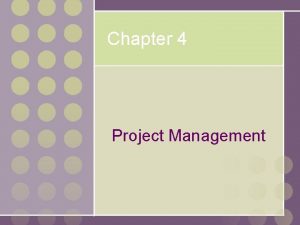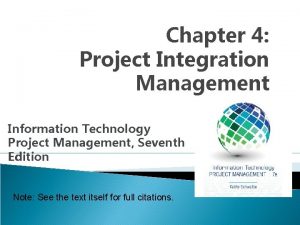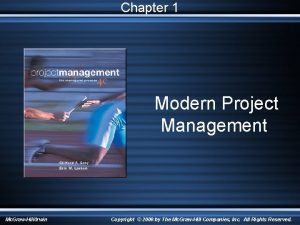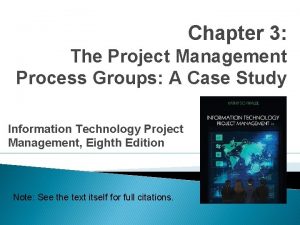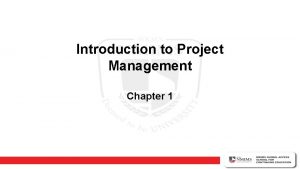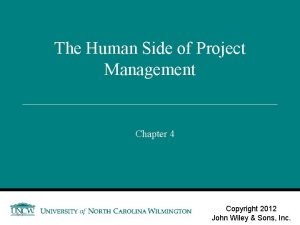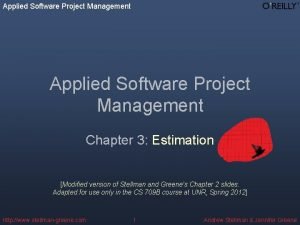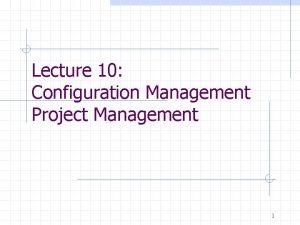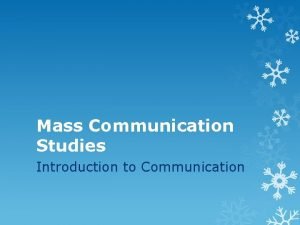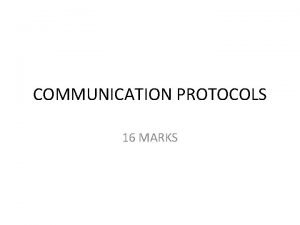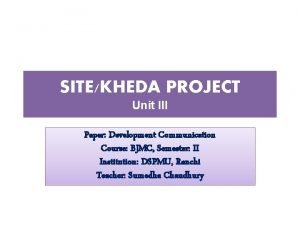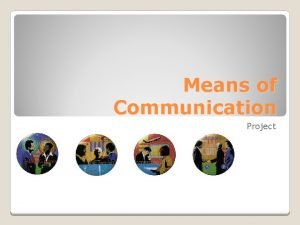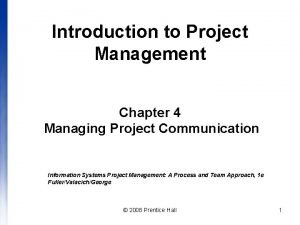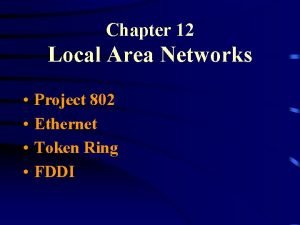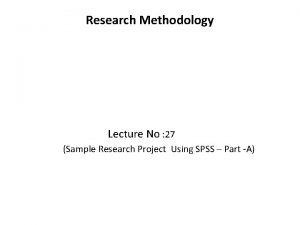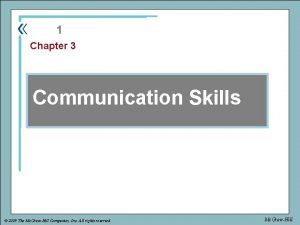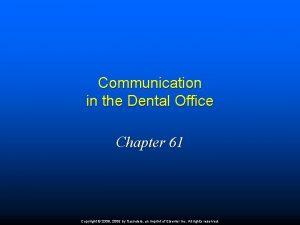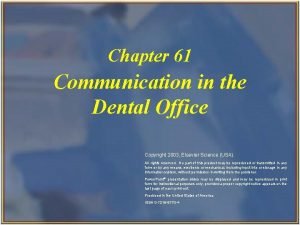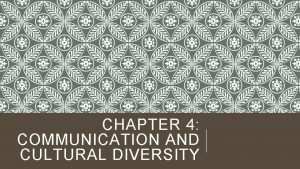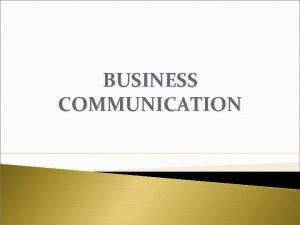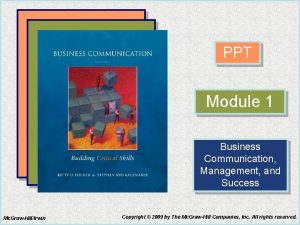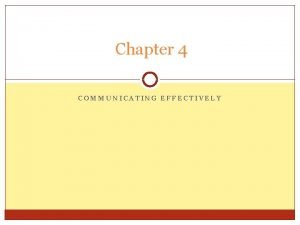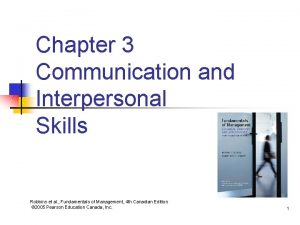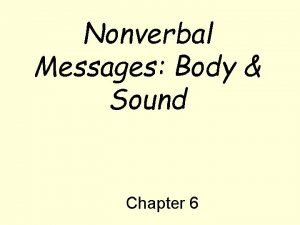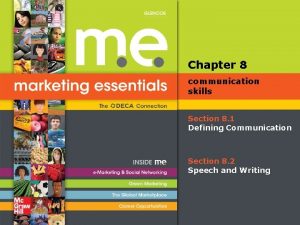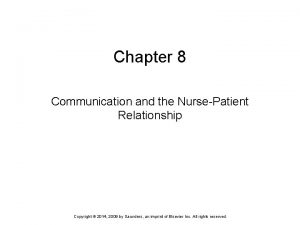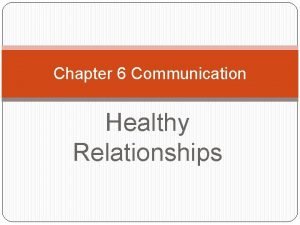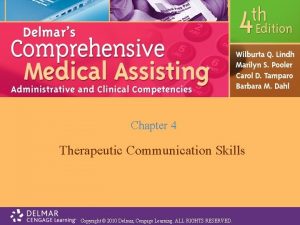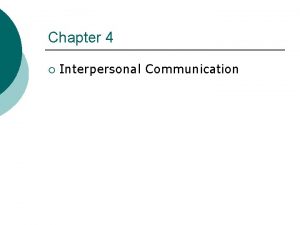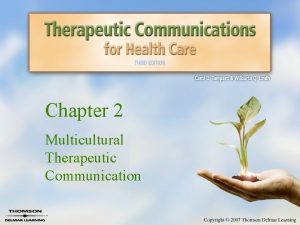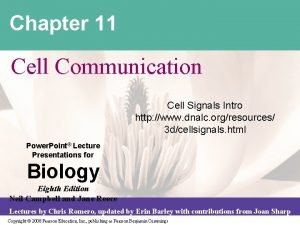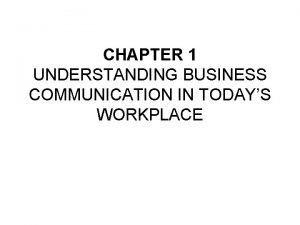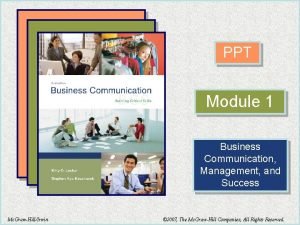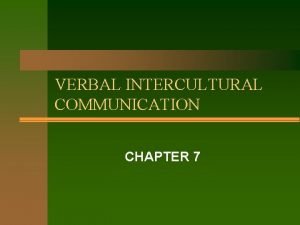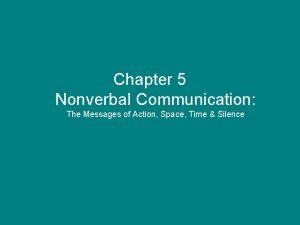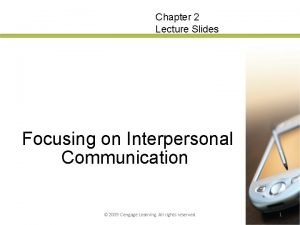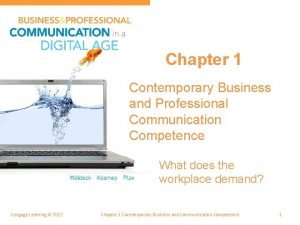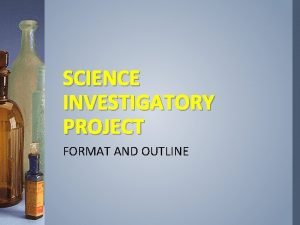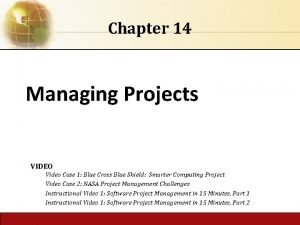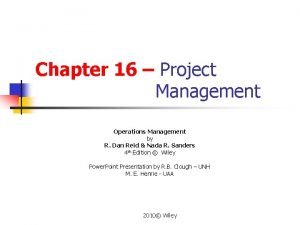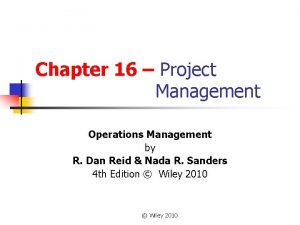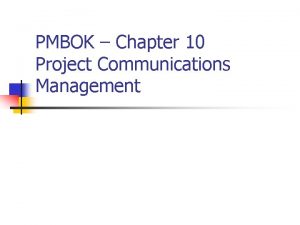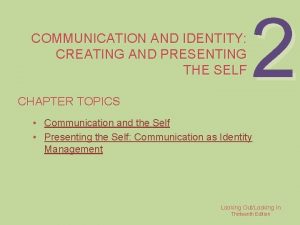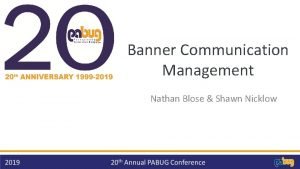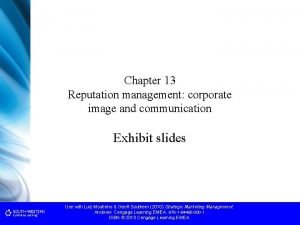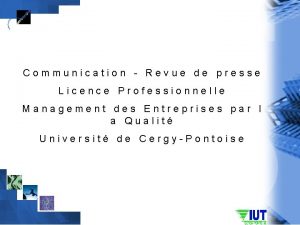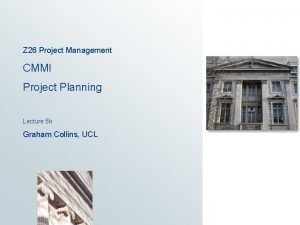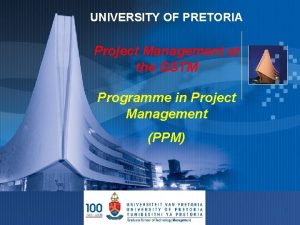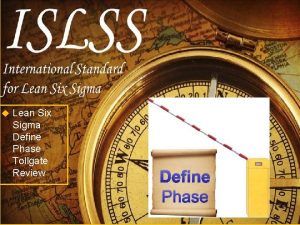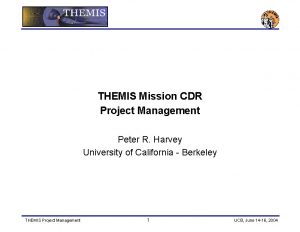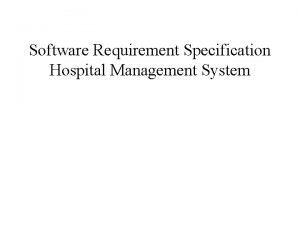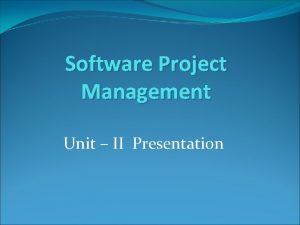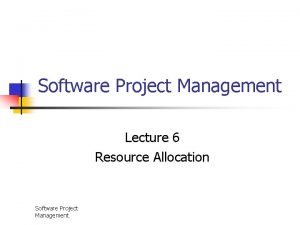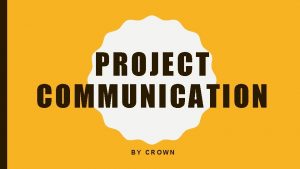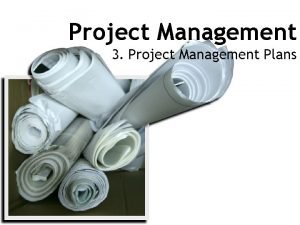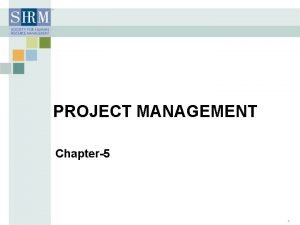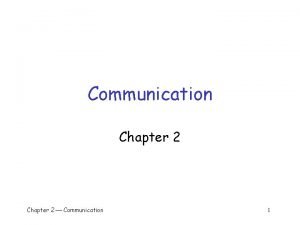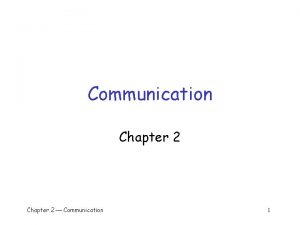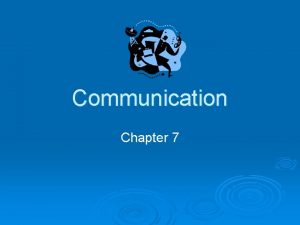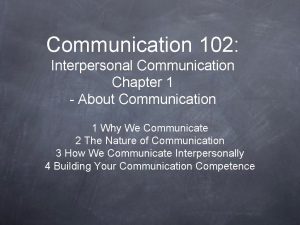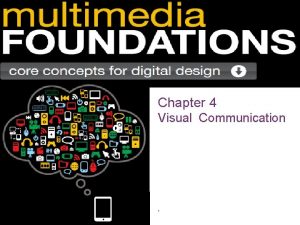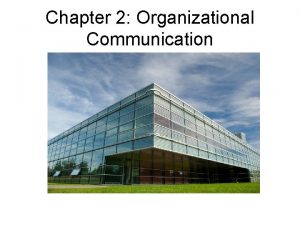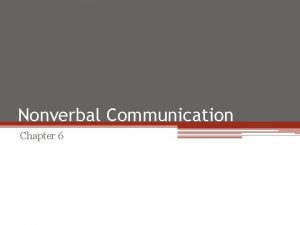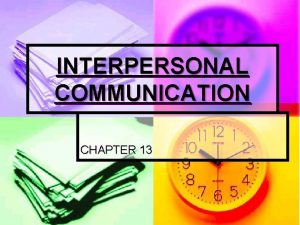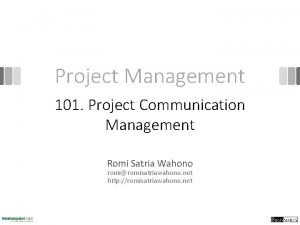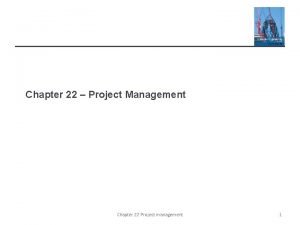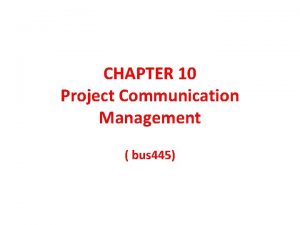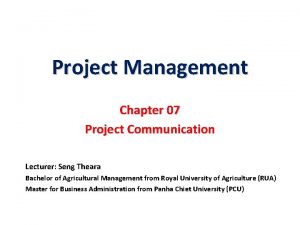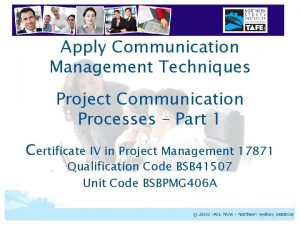Chapter 10 Project Communication Management Project Communication Management






































































































- Slides: 102

Chapter 10 Project Communication Management

Project Communication Management consists of two parts. • Developing a strategy to ensure effective communication for stakeholders. • Carrying out the necessary activities necessary to implement the communication strategy.

The Project Communication Management processes are: 10. 1 Plan Communications Management 10. 2 Manage Communications 10. 3 Monitor Communications

Figure 10 -1 Project Communications Overview

Key Concepts for Project Communications Management Communication is the exchange of information, intended or involuntary. The information exchanged can be in various forms.

The mechanisms by which information is exchanged can be in: § Written form § Spoken § Formal or informal § Through gestures § Through media § Choice of words

Communications describes the possible means by which information can be sent or received. Project managers spend most of their time communicating with team members and other project stakeholders, both internal and external. Effective communication builds a bridge between diverse stakeholders.

Communication activities have many dimensions, including but limited to: § Internal § External § Formal § Informal

§ Hierarchical focus § Upward § Downward § Horizontal § Official § Unofficial § Written and oral

For successful managing project relationships with stakeholders, communication includes developing strategies and plans for suitable communications artifacts and activities with the stakeholder community and the application of skills to enhance the effectiveness of the planned and other ad hoc communications.

There are two parts to successful communication: The first part involves developing the right communication strategy based on the needs of the project and the project’s stakeholders. The second part is successful communication.

The project’s communications are supported by trying to prevent misunderstanding and miscommunication and by careful selection of the methods, messengers, and messages developed from the planning process.

Misunderstandings can be reduced by using the 5 Cs of written communication: § Correct grammar and spelling § Concise expression and elimination of excess words § Clear purpose and expression directed to the needs of the reader § Coherent logical flow of ideas § Controlling flow of words and ideas

The 5 Cs of written communications are supported by these communication skills: § Listening actively § Awareness of cultural and personal differences § Identifying, setting and managing stakeholder expectations

§ Enhancement of skills: § § § Persuading to perform an action Motivating and encouraging Coaching to improve performance and achieve desired results § Negotiating to achieve acceptable agreements and reduce delays § Resolving conflict

Fundamental attributes of effective communication activities and developing effective communication artifacts: § Clarity on the purpose of the communication § Understanding about the receiver of the communications, meeting needs and preferences § Monitoring and measuring the effectiveness of the communication

Trends and Emerging Practices In Project Communication Management § Inclusion of stakeholders in project reviews § Inclusion of stakeholders in project meetings § Increased use of social computing § Multifaceted approaches to communication

Tailoring Considerations The project team needs to tailor the way that Project Communications Management processes are applied because each project is different.

Considerations for Tailoring: § Stakeholders § Physical location § Communications technology § Language § Knowledge management

Considerations For Agile/Adaptive Environments Project environments subject to various elements of ambiguity and change have an inherent need to communicate evolving and emerging details more frequently and quickly. Posting project artifacts in a transparent way, holding regular stakeholder reviews will promote communication with management and stakeholders

10. 1 Plan Communications Management The process of developing an appropriate approach and plan for project communications activities based on the information needs of each stakeholder or group, available organizational assets and the needs of the project.

Figure 10 -2 Plan Communications Management: Input, Tools & Techniques, and Outputs

Figure 10 -3. Plan Communications Management: Data Flow Diagram

Effective communications management plan recognizes the diverse information needs of the project’s stakeholders is developed early, should be reviewed regularly and modified when necessary. The information needs and methods of distribution vary widely. The methods of storage, retrieval and disposition of the project information need to be considered and documented.

10. 1. 1 Plan Communications Management: Inputs 10. 1. 1. 1 Project Charter The project charter identifies the key stakeholder list, may contain information about the roles and responsibilities of the stakeholders

10. 1. 1. 2 Project Management Plan Project management plan components include: § Resource management plan § Stakeholder engagement plan

10. 1. 1. 3 Project Documents Project documents can be considered as inputs for this process include: § Requirements documentation § Stakeholder register

10. 1. 1. 4 Enterprise Environmental Factors The enterprise environmental factors that can influence the Plan Communications Management process include: § Organizational culture, political climate, and governance framework § Personnel administration policies § Stakeholder risk thresholds

§ Established communication channels, tools and systems § Global, regional or local trends, practices or habits § Geographic distribution of facilities and resources

10. 1. 1. 5 Organizational Process Assets The organizational process assets that can influence the Plan Communications Management process include: § Organizational policies and procedures for social media, ethics and security § Organizational policies and procedures for issue, risk, change and data management

§ Standardized guidelines for development, exchange, storage, and retrieval of information § Historical information and lessons learned repository § Stakeholder and communications data and information from previous projects

10. 1. 2 Plan Communications Management: Tools and Techniques 10. 1. 2. 1 Expert Judgment Expertise should be considered from individuals or groups with specialized knowledge or training in the following topics: § Politics and power structures in the organization § Environment and culture of the organization and other customer organizations

§ Organizational change management approach and practices § Industry or type of project deliverables § Organizational communications technologies § Organizational policies and procedures regarding legal requirements of corporate communications § Organizational policies and procedures regarding security § Stakeholders, including customers or sponsors

10. 1. 2. 2 Communication Requirements Analysis of communication requirements determines the information needs of the project stakeholders. These requirements are defined by combining the type and format of information needed with an analysis of the value of the information.

Sources of information typically used to identify and define project communication requirements include: § Stakeholder information and communication requirements from within the stakeholder register and stakeholder engagement plan § Number of potential communication channels or paths, including one-to-one, one-to-many, and many-to-many communications § Organizational charts

§ Project organization and stakeholder responsibility, relationships and interdependencies § Development approach § Disciplines, departments and specialties involved in the project § Logistics of how many persons will be involved with the project and at which location

§ Internal information needs (e. g. when communicating within organizations) § External information needs (e. g. when communicating with the media, public or contractors) § Legal requirements

10. 1. 2. 3 Communication Technology Common methods used for information exchange and collaboration include: § Conversations § Meetings § Written documents § Databases § Social media § Websites

Factors that affect the choice of communication technology: § Urgency of the need for information § Availability and reliability of technology § Ease of use § Project environment

§ Sensitivity and confidentiality of the information § Whether information to be communicated is sensitive or confidential. If so, additional security measures may be required. § Social media policies for employees to ensure appropriate behavior, security and the protection of proprietary information.

10. 1. 2. 4 Communication Models Communication models can represent the communication process in its most basic linear form, a more interactive form or in a more complex model.

Sample basic sender/receiver communication model The model describes communication as a process and has two parties; the sender and the receiver. This model makes sure the message is delivered. The steps in a basic communication model: § Encode § Transmit message § Decode

Sample interactive communication model This model has two parties, the sender and receiver, but recognizes the need to of the message is understood. Additional steps in an interactive communication model: § Acknowledge § Feedback/response

Cross-cultural communication presents challenges to ensuring that the meaning of the message has been understood. Differences in communication styles can come from: § Differences in working methods § Age § Nationality § Professional discipline § Ethnicity § Race § Gender

Figure 10 -4: Communications Model for Cross-Cultural Communication

10. 1. 2. 5 Communication Methods Classification of communication methods used to share information among project stakeholders: § Interactive communication § Push communication § Pull communication

Different approaches should be used to meet the needs of the major forms of communication defined in the communication management plan: § Interpersonal communication § Small group communication § Public communication § Mass communication § Networks and social computing communication

Possible communication artifacts and methods: § Notice boards § Newsletters/in-house magazines/e-magazines § Letters to staff/volunteers § Press releases § Annual reports § Emails and intranets § Web portals and other information repositories (for pull communication)

§ Phone conversations § Presentations § Team briefings/group meetings § Focus groups § Face-to-face formal or informal meetings between various stakeholders § Consultation groups or staff forums § Social computing technology and media

10. 1. 2. 6 Interpersonal and Team Skills Interpersonal and team skills that can be used: § Communication styles assessment § Political awareness § Cultural awareness

10. 1. 2. 7 Data Representation Data representation technique that can be used for this process includes a stakeholder engagement assessment matrix. Stakeholder engagement assessment matrix shows gaps between current and desired engagement levels of individual stakeholders.

10. 1. 2. 8 Meetings can include virtual meetings or face-to -face meetings. Meetings can be supported with document collaboration techniques, which can include email messages and project websites.

10. 1. 3 Plan Communication Management: Outputs 10. 1. 3. 1 Communications Management Plan Describes how project communications will be planned, structured, implemented and monitored for effectiveness.

The plan contains the following information: § Stakeholder communication requirements § Information to be communicated, including language, format, content and level of detail § Escalation process § Reason for the distribution of that information § Timeframe and frequency for the distribution of required information and receipt of acknowledgement or response

§ Person responsible for communication the information § Person responsible for authorizing release of confidential information § Person or groups who will receive the information, including information about their needs, requirements, and expectations § Methods or technologies used to convey the information, such as memos, email, press releases, or social media

§ Resources allocated for communication activities, including time and budget § Method for updating and refining the communications management plan as the project progresses and develops, such as when the stakeholder community changes as the project moves through different phases § Glossary of common technology § Flow chart of the information flow in the project, workflows with possible sequence of authorization, list of reports, meeting plans, etc. § Constraints derived from specific legislation or regulation, technology, organizational policies, etc.

10. 1. 3. 2 Project Management Plan Updates The stakeholder engagement plan is updated to reflect any processes, procedures, tools or techniques that affect the engagement of stakeholders in project decisions and execution.

10. 1. 3. 3 Project Documents Updates Project documents may be updated by: § Project schedule § Stakeholder register

10. 2 Manage Communications Management Communications is the process of ensuring timely and appropriate collection, creation, distribution, storage, retrieval, management, monitoring and the disposition of project information. The key benefit is that it enables an efficient and effective information flow between the project team and stakeholders.

The Manage Communications process identifies all aspects of effective communication and it should allow for flexibility in the communications activities.

Figure 10 -5. Manage Communications: Inputs, Tools & Techniques, and Outputs

Figure 10 -6. Manage Communications: Data Flow Diagram

Techniques and considerations for effective communications management: Project management plan components: § Sender-receiver models § Choice of media § Writing style § Meeting management § Presentations § Facilitation § Active listening

10. 2. 1 Manage Communications: Inputs 10. 2. 1. 1 Project Management Plan § Resource management plan § Communications management plan § Stakeholder engagement plan

10. 2. 1. 2 Project Documents Project document that can be considered as inputs: § Change log § Issue log § Lessons learned register § Quality report § Risk report § Stakeholder register

10. 2. 1. 3 Work Performance Reports Work performance reports include status reports and progress reports. They can contain earned value graphs and information, trend lines and forecasts, reserve burn down charts, defect histograms, contract performance information and risk summaries. They can be presented as dashboards, heat reports, or stop light charts.

10. 2. 1. 4 Enterprise Environmental Factors The enterprise environmental factors: § Organizational culture, political climate, and governance framework § Personnel administration policies § Stakeholder risk thresholds § Established communication channels, tools, and systems

§ Global, regional, or local trends and practices or habits § Geographic distribution of facilities and resources

10. 2. 1. 5 Organizational Process Assets The organizational process assets: § Corporate policies and procedures for social media, ethics, and security § Corporate policies and procedures for issue, risk, change, and data management § Organizational communication requirements § Standardized guidelines for development, exchange, storage and retrieval of information § Historical information from previous projects, including the lessons learned repository

10. 2. 2 Manage Communications: Tools and Techniques 10. 2. 2. 1 Communication Technology Factors that influence the technology include whether the team is collocated, the confidentiality of information that needs to be shared, resources available to team members and how the organization’s culture influences the way meetings and discussions are conducted.

10. 2. 2. 2 Communication Methods The choice of communication methods should allow flexibility in the event that the membership of the stakeholder community changes or their needs and expectations change.

10. 2. 2. 3 Communication Skills Communication techniques that can be used: § Communication competence § Feedback § Nonverbal

§ Presentations § Progress reports and information updates to stakeholders § Background information to support decision making § General information about the project and its objectives, for the purpose of raising the profile of the work of the project and the team § Specific information aimed at increasing understanding and support of the work and objectives of the project

Presentations will be successful when the content and delivery take the following into account: § The audience, their expectations, and needs § The needs and objectives of the project and project team

10. 2. 2. 4 Project Management Information System (PMIS) Project management information systems ensure that stakeholders can easily retrieve the information they need in a timely way. Project information is managed and distributed using: § Electronic project management tools § Electronic communications management § Social media management

10. 2. 2. 5 Project Reporting Project reporting is the act of collecting and distributing project information. Information is given to many groups of stakeholders and should be adapted to provide information at an appropriate level, format and detail for each type of stakeholder. Formats can range from simple to more elaborate reports and presentations.

10. 2. 2. 6 Interpersonal and Team Skills Interpersonal and team skills that can be used: § Active listening § Conflict management § Meeting management § Prepare and distribute the agenda stating the objectives of the meeting § Ensure that the meetings start and finish at the published time

§ Meeting management con’t: § Ensure the appropriate participants are invited and attend § Stay on topic § Manage expectations, issues, and conflicts during the meeting § Record all actions and those who have been allocated the responsibility for completing action § Networking § Political awareness

10. 2. 2. 7 Meetings support the actions defined in the communication strategy and communications plan.

10. 2. 3 Manage Communications: Outputs 10. 2. 3. 1 Project Communications Project communications artifacts may include: § Performance reports, § Deliverable status § Schedule progress § Cost incurred § Presentations § Other information required by stakeholders

10. 2. 3. 2 Project Management Plan Updates Components of the project management plan that may be updated because of a change to the project management plan: § Communications management plan § Stakeholder engagement plan

10. 2. 3. 3 Project Documents Updates Project documents that may be updated: § Issue log § Lessons learned register § Project schedule § Risk register § Stakeholder register

10. 2. 3. 4 Organizational Process Assets Updates Organizational process assets that may be updated: § Project records such as correspondence, memos, meeting minutes and other documents used on the project § Planned and ad hoc project reports and presentations

10. 3 Monitor Communications is the process of ensuring the information needs of the project and its stakeholders are met. The key benefit of this process is the optimal information flow as defined in the communications management plan and the stakeholder engagement plan. This is performed throughout the project.

Figure 10 -7. Monitor Communications: Inputs, Tools & Techniques, and Outputs

Figure 10 -8. Monitor Communications: Data Flow Diagram

Monitor Communications determines if the planned communications artifacts and activities have had the desired effect of increasing or maintaining stakeholders’ support for the project’s deliverables and expected outcomes. There a variety of monitor communication methods: customer satisfaction surveys, collecting lessons learned, observations of the team, reviewing data for the issue log or evaluating changes in the stakeholder engagement assessment matrix.

10. 3. 1 Monitor Communications: Inputs 10. 3. 1. 1 Project Management Plan Project management plan components: § Resource management plan § Communications management plan § Stakeholder engagement plan

10. 3. 1. 2 Project Documents Project documents that can be considered: § Issue log § Lessons learned register § Project communications

10. 3. 1. 3 Work Performance Data Work performance data contains data on the types and quantities of communications that have actually been distributed.

10. 3. 1. 4 Enterprise Environmental Factors The enterprise environmental factors that can influence the Monitor Communication process: § Organizational culture, political climate, and governance framework § Established communication channels, tools and systems § Global, regional or local trends, practices or habits § Geographic distribution of facilities and resources

10. 3. 1. 5 Organizational Process Assets The organizational process assets that may influence the Monitor Communications process: § Corporate policies and procedures for social media, ethics and security § Organizational communication requirements § Standardized guidelines for development, exchange, storage and retrieval of information

§ Historical information and lessons learned repository from previous projects § Stakeholder and communications data and information from previous projects

10. 3. 2 Monitor Communications: Tools and Techniques 10. 3. 2. 1 Expert Judgment Expertise should be considered from individuals or groups with specialized knowledge or training in the following topics: § Communications with the public, the community, and the media, and, in an international environment, between virtual groups § Communications and project management systems

10. 3. 2. 2 Project Management Information System (PMIS) Project management information systems provides a set of standard tools for the project manager to capture, store and distribute information to internal and external stakeholders.

10. 3. 2. 3 Data Representation A data representation technique that can be used includes but is not limited to the stakeholder engagement assessment matrix, which can provide information about the effectiveness of the communications activities.

10. 3. 2. 4 Interpersonal and Team Skills Interpersonal and team skills that can be used for this process are observation/conversation. Observation and conversation allows the project manager to identify issues with the team, conflicts between people or individual performance issues.

10. 3. 2. 5 Meetings Face-to-face or virtual meetings are used to make decisions, respond to stakeholder requests and have discussions with suppliers, vendors or other project stakeholders.

10. 3. 3 Monitor Communications: Outputs 10. 3. 3. 1 Work Performance Information Work performance information includes information on how project communication is performing by comparing the communications that were implemented to the ones planned.

10. 3. 3. 2 Change Requests Change requests are processed through the Perform Integrated Change Control process. Change requests may result in: § Revision of stakeholder communication requirements, including stakeholders’ information distribution, content or format and distribution method § New procedures to eliminate bottlenecks

10. 3. 3. 3 Project Management Plan Updates Any change goes through the change control process using a change request. Components that may require a change request may include: § Communications management plan § Stakeholder engagement plan

10. 3. 3. 4 Project Documents Updates Project documents that may be updated as a result of carrying out this process may include: § Issue log § Lessons learned register § Stakeholder register
 Importance of software project management
Importance of software project management The role of project management in achieving project success
The role of project management in achieving project success Iteration workflows in software project management
Iteration workflows in software project management Reducing project duration examples
Reducing project duration examples Modern project management began with what project
Modern project management began with what project What is strategic assessment in software project management
What is strategic assessment in software project management Perpetual project closure
Perpetual project closure Microsoft project agile
Microsoft project agile Project termination
Project termination Chapter 3 project management
Chapter 3 project management A series of coordinated related multiple projects
A series of coordinated related multiple projects Project management chapter 6
Project management chapter 6 Project management chapter 4
Project management chapter 4 Directing and managing project execution
Directing and managing project execution Chapter 1 modern project management
Chapter 1 modern project management Project management chapter 3
Project management chapter 3 Project management chapter 1
Project management chapter 1 Project management chapter 4
Project management chapter 4 Project management chapter 3
Project management chapter 3 Asset management vs project management
Asset management vs project management Configuration management project management
Configuration management project management Principles of cost management
Principles of cost management Software
Software What is project integration management
What is project integration management Operations management chapter 12 inventory management
Operations management chapter 12 inventory management Top management and middle management
Top management and middle management Management pyramid
Management pyramid Top management and middle management
Top management and middle management Parallel and serial port
Parallel and serial port What is oral communication and written communication
What is oral communication and written communication Parallel communication examples
Parallel communication examples Mass communication
Mass communication Difference between oral and written communication
Difference between oral and written communication Serial communication vs parallel communication
Serial communication vs parallel communication Kheda communication project
Kheda communication project Different types of communication
Different types of communication Project communication matrix
Project communication matrix Project 802 in data communication network
Project 802 in data communication network Background of project
Background of project Process indicators enable software project manager to
Process indicators enable software project manager to Methodology of project sample
Methodology of project sample Chapter 3 communication skills
Chapter 3 communication skills 6 interpersonal skills
6 interpersonal skills Chapter 61 communication in the dental office
Chapter 61 communication in the dental office Chapter 61 communication in the dental office
Chapter 61 communication in the dental office Chapter 4 communication and cultural diversity
Chapter 4 communication and cultural diversity Reviewing and correcting the final draft of a message is
Reviewing and correcting the final draft of a message is Laswell's model
Laswell's model Paiboc model
Paiboc model Chapter 5 interpersonal communication
Chapter 5 interpersonal communication Sier hierarchy
Sier hierarchy Chapter 3 communication skills
Chapter 3 communication skills Adler and rodman 2006
Adler and rodman 2006 Chapter 1 understanding business communication
Chapter 1 understanding business communication Business communication today chapter 1
Business communication today chapter 1 Olfactics refers to
Olfactics refers to Chapter 8 communication skills
Chapter 8 communication skills Chapter 8 health team communication
Chapter 8 health team communication Chapter 6 communication and relationships
Chapter 6 communication and relationships Chapter 4 therapeutic communication skills
Chapter 4 therapeutic communication skills Noise in communication
Noise in communication Multicultural therapeutic communication skills
Multicultural therapeutic communication skills Dot
Dot Business communication chapter 1 pdf
Business communication chapter 1 pdf Memos and emails
Memos and emails Business communication skills ppt
Business communication skills ppt Vocalics images
Vocalics images Organizing business messages
Organizing business messages Business communication - culture and ethics
Business communication - culture and ethics Cultural diversity 3939 answers
Cultural diversity 3939 answers Preview of main points
Preview of main points Tactilics
Tactilics Interpersonal relationship
Interpersonal relationship Strategies for effective interpersonal communication
Strategies for effective interpersonal communication Chapter 8 interpersonal communication
Chapter 8 interpersonal communication Chapter 5 nonverbal communication
Chapter 5 nonverbal communication Interpersonal communication chapter 2
Interpersonal communication chapter 2 Chapter 11 cell communication
Chapter 11 cell communication Chapter 1 professional communication
Chapter 1 professional communication Project outline examples
Project outline examples Blue project chapter 5
Blue project chapter 5 Blue project chapter 14
Blue project chapter 14 Project s chapter 16
Project s chapter 16 Project s chapter 16
Project s chapter 16 Pmbok communication plan
Pmbok communication plan Identity management in communication
Identity management in communication Retail communication mix
Retail communication mix Banner communication management
Banner communication management Reputation management corporate image and communication
Reputation management corporate image and communication Revue communication et management
Revue communication et management Communication management pmbok
Communication management pmbok Cmmi level 3 documentation templates
Cmmi level 3 documentation templates Project procurement management lecture notes
Project procurement management lecture notes Vehicle management system login
Vehicle management system login Project management course university of pretoria
Project management course university of pretoria Tollgate definition
Tollgate definition Pdr cdr project management
Pdr cdr project management Risk event life cycle
Risk event life cycle Management spectrum includes
Management spectrum includes Telecom risk management
Telecom risk management Hospital management er diagram
Hospital management er diagram Strategic assessment in spm
Strategic assessment in spm Allocation management software
Allocation management software












